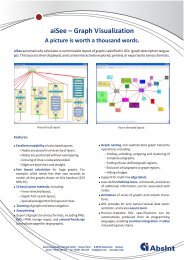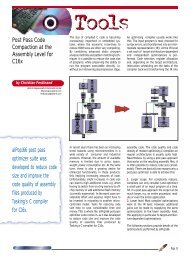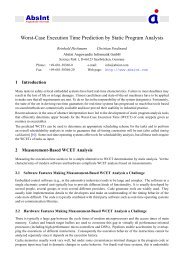5 Graph Description Language (GDL) - Absint
5 Graph Description Language (GDL) - Absint
5 Graph Description Language (GDL) - Absint
You also want an ePaper? Increase the reach of your titles
YUMPU automatically turns print PDFs into web optimized ePapers that Google loves.
sorting to assign ranks to nodes. This is much faster, however it requires that the graph be<br />
acyclic.<br />
• tree:<br />
This method is very fast, however it can’t be used unless the graph is a forest of downward<br />
laid-out trees. A downward laid-out tree has the following structure: Each node at rank l<br />
has at most one adjacent edge coming from a node of an upper rank k < l. A node may have<br />
edges pointing to nodes at the same level and edges coming from nodes of lower ranks k > l.<br />
The direction of the edges may be arbitrary, but the picture of the layout (if the arrow heads<br />
are ignored) has to be a tree (see Figure 31). The assignment of ranks is done by DFS. Then,<br />
the graph is checked to determine whether it is a forest of downward laid-out trees. If this<br />
is not the case, the standard layout is used as a fallback solution. Crossing reduction (see<br />
next section) is not necessary for downward laid-out trees, meaning a very fast positioning<br />
algorithm can be used.<br />
Figure 31: Downward Laid-out Trees and Structural Trees<br />
A further possibility for influencing the layout is edge priority. Higher priority edges are preferable<br />
when calculating the spanning tree. After partitioning, a fine-tuning phase tries to improve the<br />
ranks in order to avoid very long edges.<br />
6.4.2 Crossing Reduction<br />
This pass calculates a good order of the nodes within levels ao as to avoid edge crossings. The first<br />
step is to separate connected components of the graph and to handle each component separately.<br />
The crossing reduction algorithm calculates the weights of the nodes in keeping with the possible<br />
crossings to the left and the right, and reorders the nodes of a level according to these weights.<br />
118





